Competitiveness in Palm Oil Industry: An Analysis of Malaysia
VerifiedAdded on 2023/06/03
|16
|3337
|238
Report
AI Summary
This report examines the competitiveness of Malaysia's palm oil industry, considering the country's overall economic environment. It analyzes key players like Sime Darby, IOI Corporation, Kuala Lumpur Kepong, Genting Plantations, Felda Global Ventures Holdings, and United Plantations, evaluating their market positions and financial performance. The report explores the industry's contribution to Malaysia's GDP and employment, recent advancements in palm oil biomass utilization, and the role of organizations like the Malaysian Palm Oil Council and National Key Economic Activities (NKEA) in industry development. It also discusses the investment potential within the Malaysian palm oil sector, considering the growth rates and challenges faced by the leading companies.
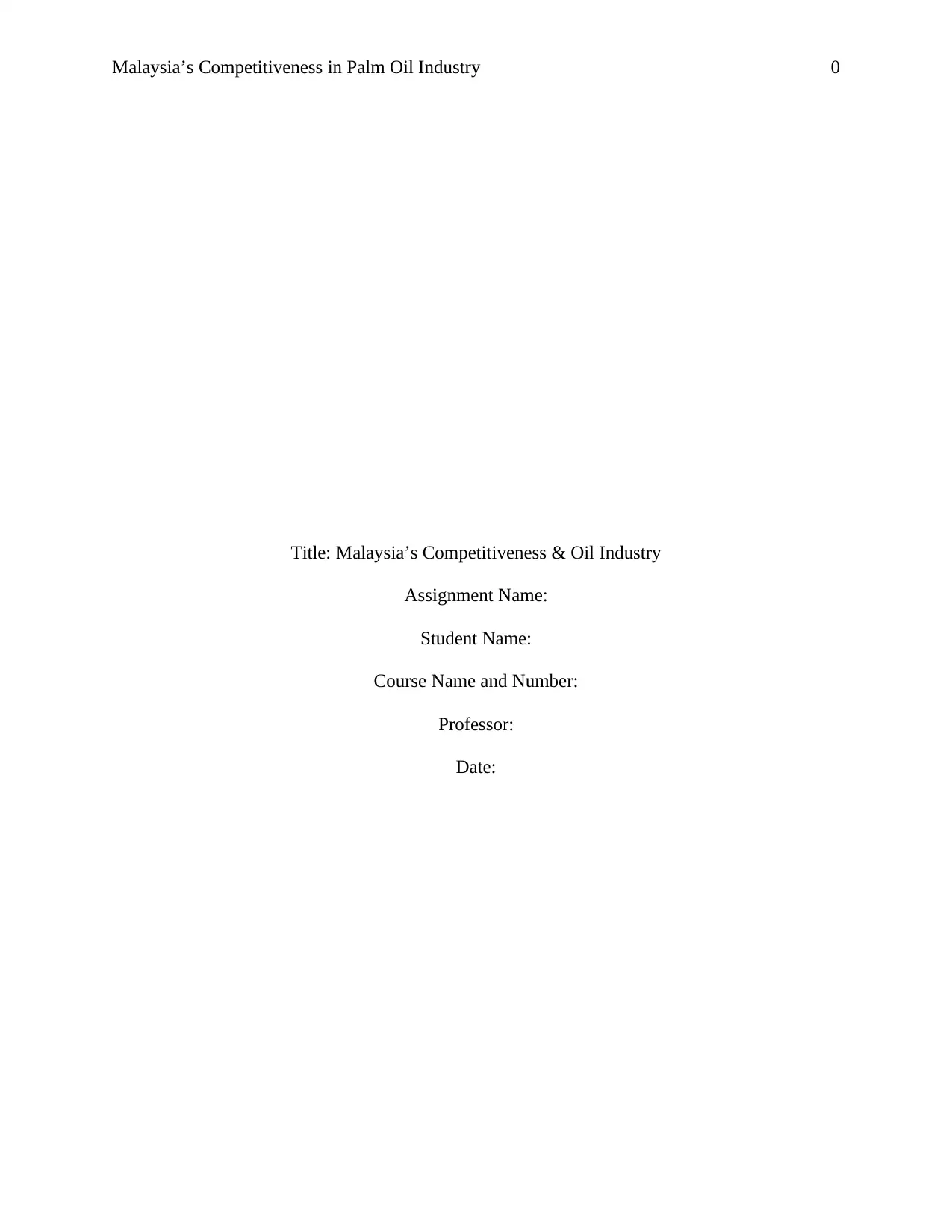
Malaysia’s Competitiveness in Palm Oil Industry 0
Title: Malaysia’s Competitiveness & Oil Industry
Assignment Name:
Student Name:
Course Name and Number:
Professor:
Date:
Title: Malaysia’s Competitiveness & Oil Industry
Assignment Name:
Student Name:
Course Name and Number:
Professor:
Date:
Paraphrase This Document
Need a fresh take? Get an instant paraphrase of this document with our AI Paraphraser
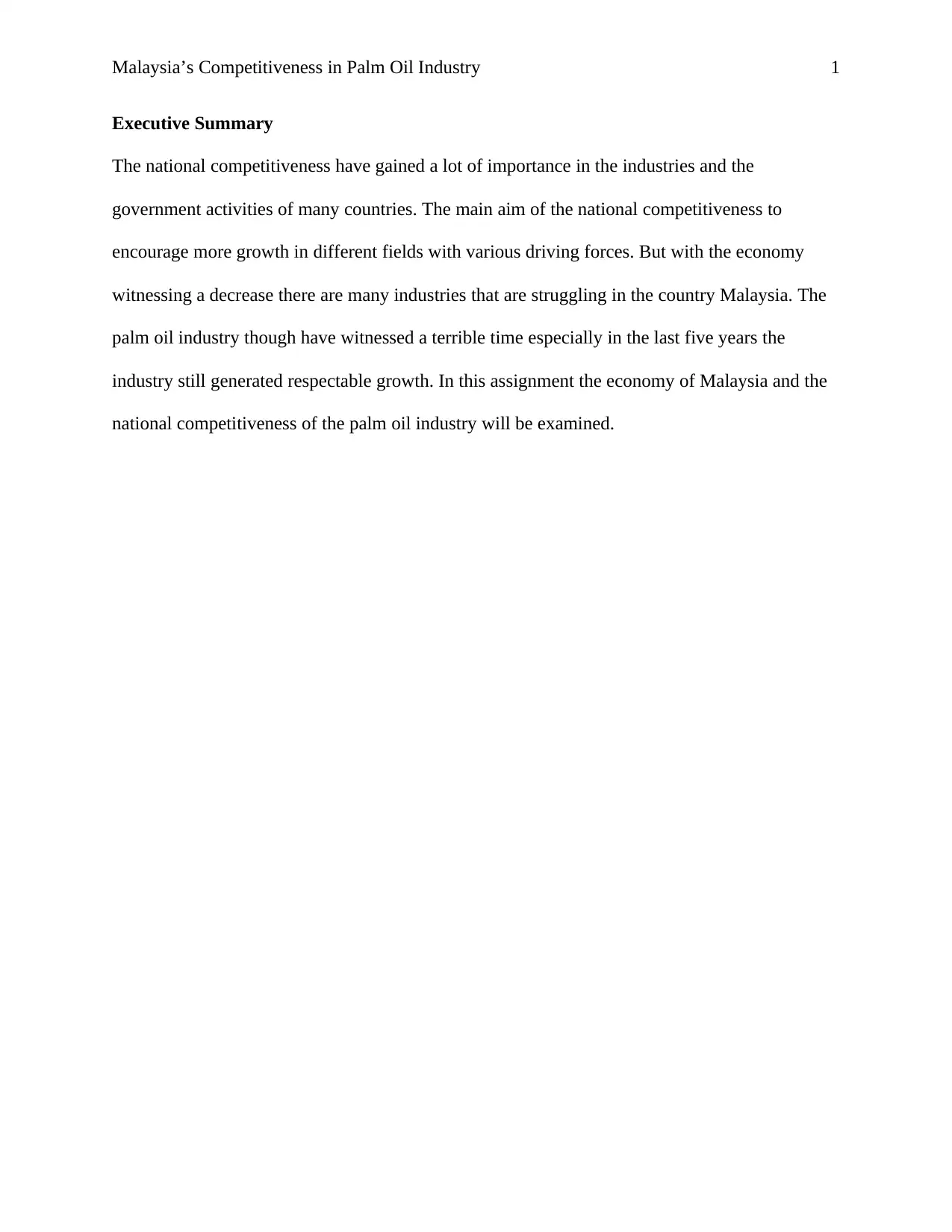
Malaysia’s Competitiveness in Palm Oil Industry 1
Executive Summary
The national competitiveness have gained a lot of importance in the industries and the
government activities of many countries. The main aim of the national competitiveness to
encourage more growth in different fields with various driving forces. But with the economy
witnessing a decrease there are many industries that are struggling in the country Malaysia. The
palm oil industry though have witnessed a terrible time especially in the last five years the
industry still generated respectable growth. In this assignment the economy of Malaysia and the
national competitiveness of the palm oil industry will be examined.
Executive Summary
The national competitiveness have gained a lot of importance in the industries and the
government activities of many countries. The main aim of the national competitiveness to
encourage more growth in different fields with various driving forces. But with the economy
witnessing a decrease there are many industries that are struggling in the country Malaysia. The
palm oil industry though have witnessed a terrible time especially in the last five years the
industry still generated respectable growth. In this assignment the economy of Malaysia and the
national competitiveness of the palm oil industry will be examined.
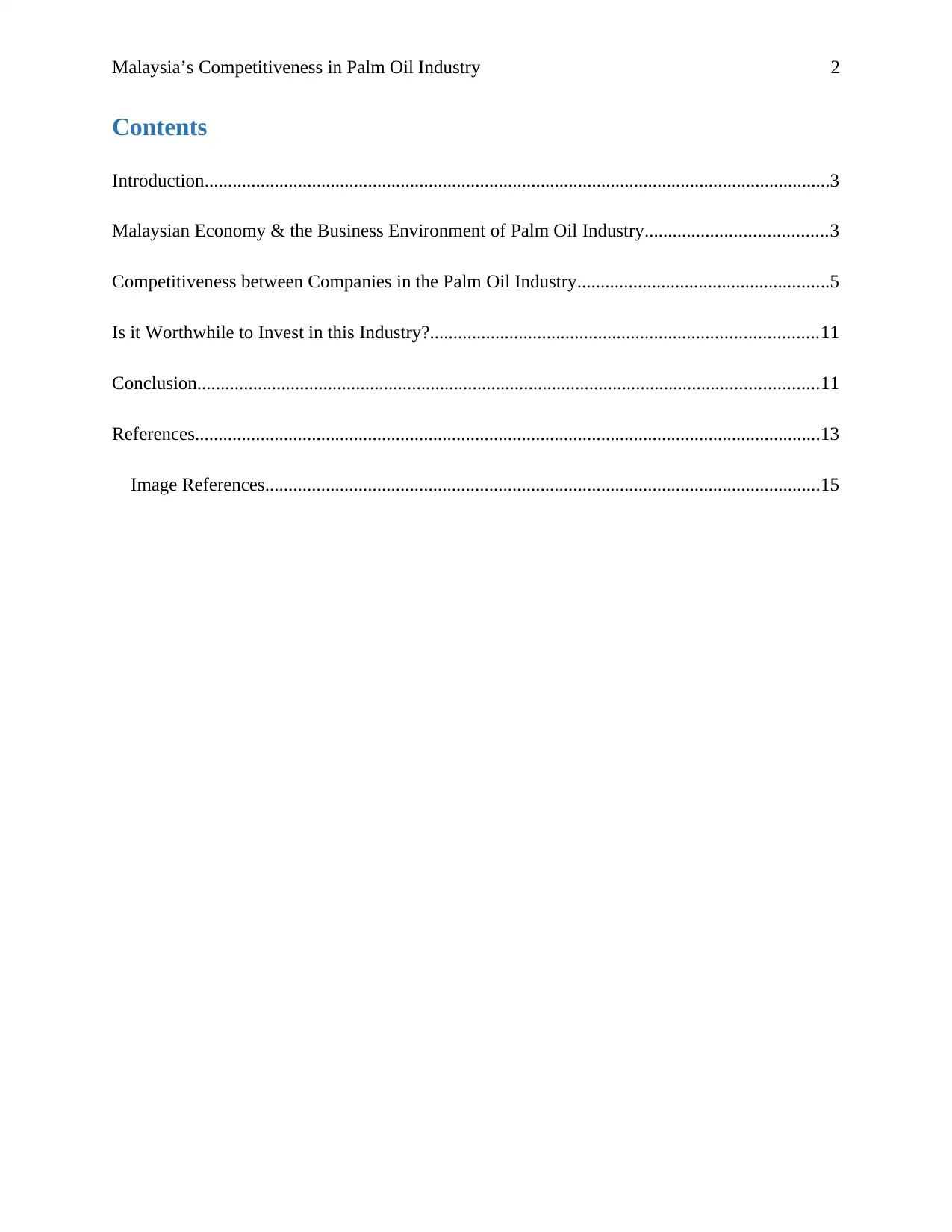
Malaysia’s Competitiveness in Palm Oil Industry 2
Contents
Introduction......................................................................................................................................3
Malaysian Economy & the Business Environment of Palm Oil Industry.......................................3
Competitiveness between Companies in the Palm Oil Industry......................................................5
Is it Worthwhile to Invest in this Industry?...................................................................................11
Conclusion.....................................................................................................................................11
References......................................................................................................................................13
Image References.......................................................................................................................15
Contents
Introduction......................................................................................................................................3
Malaysian Economy & the Business Environment of Palm Oil Industry.......................................3
Competitiveness between Companies in the Palm Oil Industry......................................................5
Is it Worthwhile to Invest in this Industry?...................................................................................11
Conclusion.....................................................................................................................................11
References......................................................................................................................................13
Image References.......................................................................................................................15
⊘ This is a preview!⊘
Do you want full access?
Subscribe today to unlock all pages.

Trusted by 1+ million students worldwide
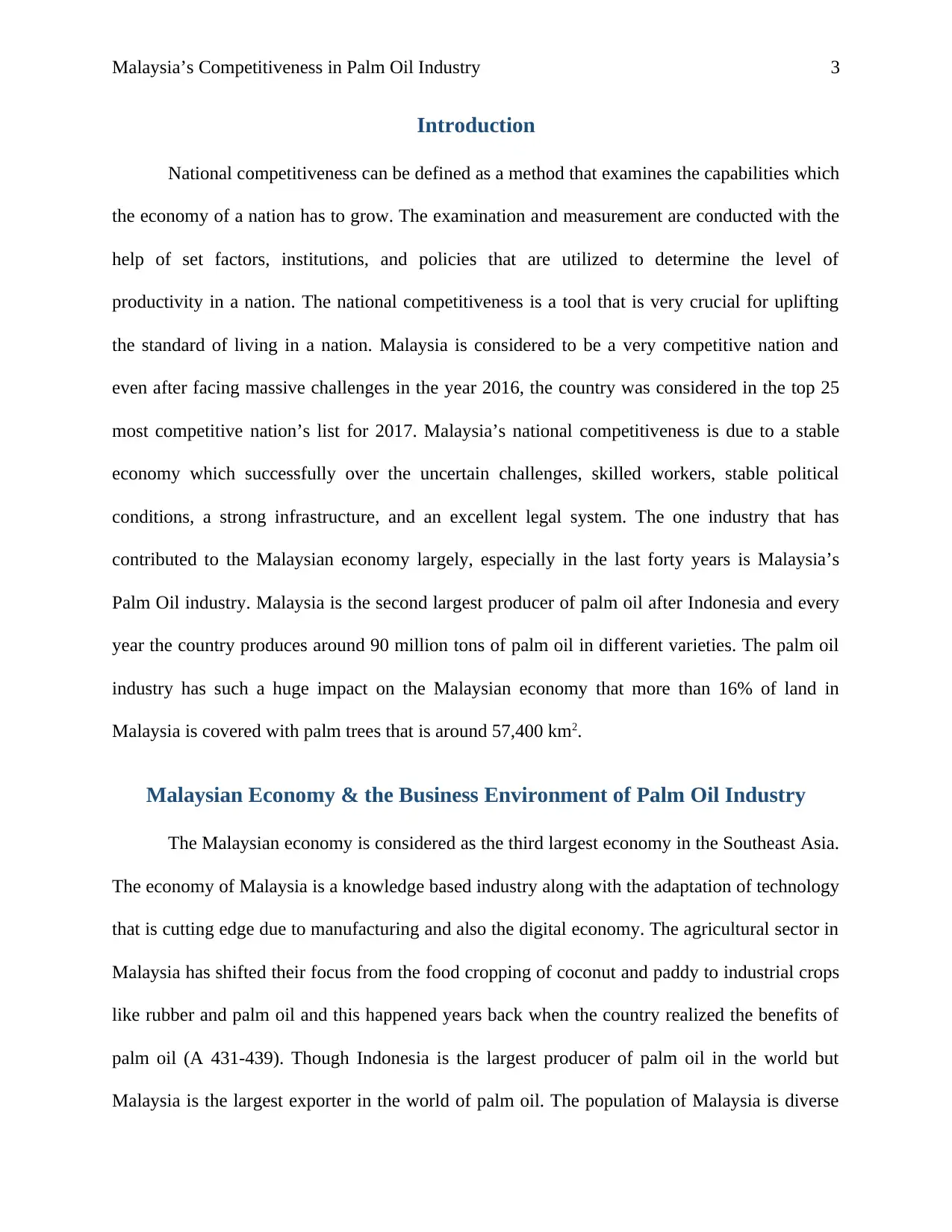
Malaysia’s Competitiveness in Palm Oil Industry 3
Introduction
National competitiveness can be defined as a method that examines the capabilities which
the economy of a nation has to grow. The examination and measurement are conducted with the
help of set factors, institutions, and policies that are utilized to determine the level of
productivity in a nation. The national competitiveness is a tool that is very crucial for uplifting
the standard of living in a nation. Malaysia is considered to be a very competitive nation and
even after facing massive challenges in the year 2016, the country was considered in the top 25
most competitive nation’s list for 2017. Malaysia’s national competitiveness is due to a stable
economy which successfully over the uncertain challenges, skilled workers, stable political
conditions, a strong infrastructure, and an excellent legal system. The one industry that has
contributed to the Malaysian economy largely, especially in the last forty years is Malaysia’s
Palm Oil industry. Malaysia is the second largest producer of palm oil after Indonesia and every
year the country produces around 90 million tons of palm oil in different varieties. The palm oil
industry has such a huge impact on the Malaysian economy that more than 16% of land in
Malaysia is covered with palm trees that is around 57,400 km2.
Malaysian Economy & the Business Environment of Palm Oil Industry
The Malaysian economy is considered as the third largest economy in the Southeast Asia.
The economy of Malaysia is a knowledge based industry along with the adaptation of technology
that is cutting edge due to manufacturing and also the digital economy. The agricultural sector in
Malaysia has shifted their focus from the food cropping of coconut and paddy to industrial crops
like rubber and palm oil and this happened years back when the country realized the benefits of
palm oil (A 431-439). Though Indonesia is the largest producer of palm oil in the world but
Malaysia is the largest exporter in the world of palm oil. The population of Malaysia is diverse
Introduction
National competitiveness can be defined as a method that examines the capabilities which
the economy of a nation has to grow. The examination and measurement are conducted with the
help of set factors, institutions, and policies that are utilized to determine the level of
productivity in a nation. The national competitiveness is a tool that is very crucial for uplifting
the standard of living in a nation. Malaysia is considered to be a very competitive nation and
even after facing massive challenges in the year 2016, the country was considered in the top 25
most competitive nation’s list for 2017. Malaysia’s national competitiveness is due to a stable
economy which successfully over the uncertain challenges, skilled workers, stable political
conditions, a strong infrastructure, and an excellent legal system. The one industry that has
contributed to the Malaysian economy largely, especially in the last forty years is Malaysia’s
Palm Oil industry. Malaysia is the second largest producer of palm oil after Indonesia and every
year the country produces around 90 million tons of palm oil in different varieties. The palm oil
industry has such a huge impact on the Malaysian economy that more than 16% of land in
Malaysia is covered with palm trees that is around 57,400 km2.
Malaysian Economy & the Business Environment of Palm Oil Industry
The Malaysian economy is considered as the third largest economy in the Southeast Asia.
The economy of Malaysia is a knowledge based industry along with the adaptation of technology
that is cutting edge due to manufacturing and also the digital economy. The agricultural sector in
Malaysia has shifted their focus from the food cropping of coconut and paddy to industrial crops
like rubber and palm oil and this happened years back when the country realized the benefits of
palm oil (A 431-439). Though Indonesia is the largest producer of palm oil in the world but
Malaysia is the largest exporter in the world of palm oil. The population of Malaysia is diverse
Paraphrase This Document
Need a fresh take? Get an instant paraphrase of this document with our AI Paraphraser
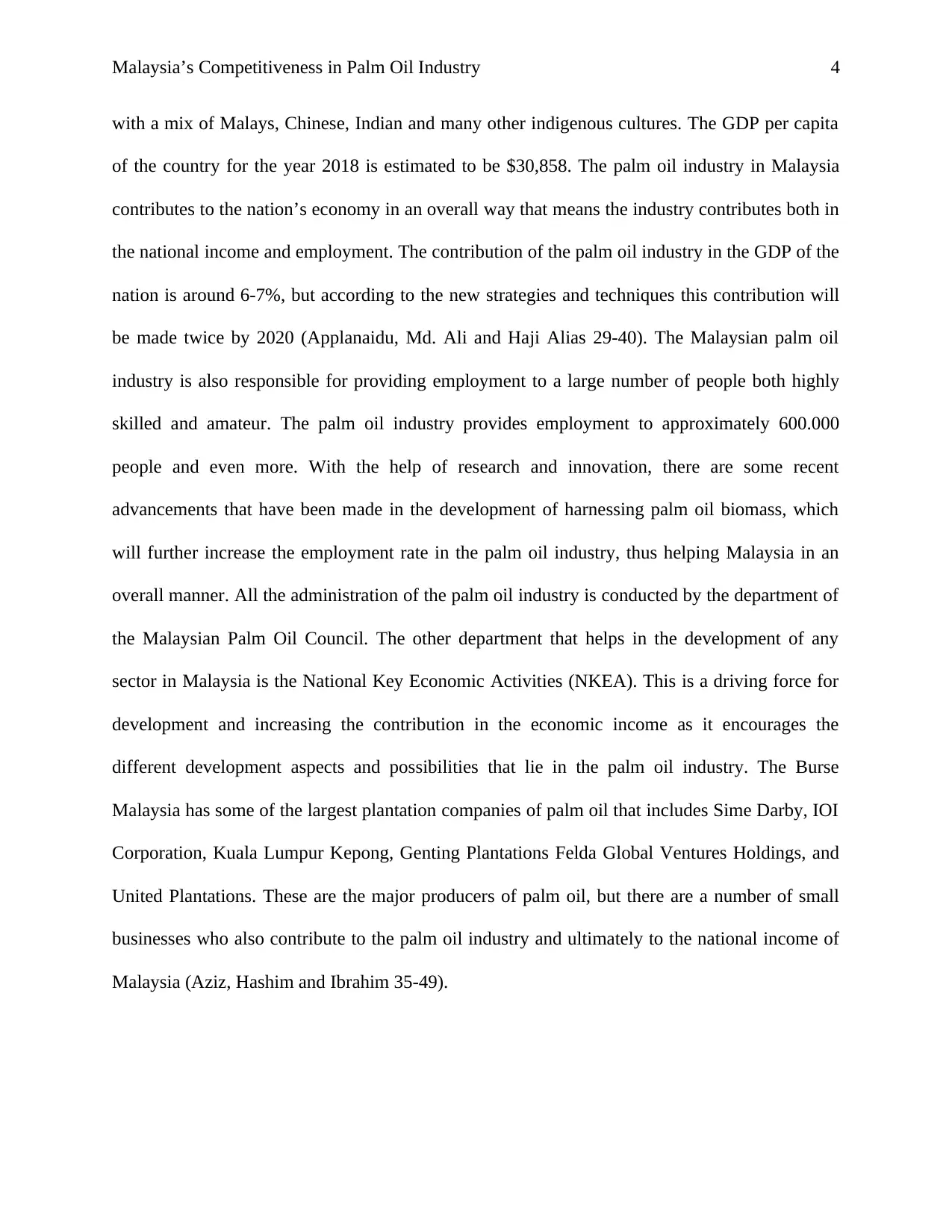
Malaysia’s Competitiveness in Palm Oil Industry 4
with a mix of Malays, Chinese, Indian and many other indigenous cultures. The GDP per capita
of the country for the year 2018 is estimated to be $30,858. The palm oil industry in Malaysia
contributes to the nation’s economy in an overall way that means the industry contributes both in
the national income and employment. The contribution of the palm oil industry in the GDP of the
nation is around 6-7%, but according to the new strategies and techniques this contribution will
be made twice by 2020 (Applanaidu, Md. Ali and Haji Alias 29-40). The Malaysian palm oil
industry is also responsible for providing employment to a large number of people both highly
skilled and amateur. The palm oil industry provides employment to approximately 600.000
people and even more. With the help of research and innovation, there are some recent
advancements that have been made in the development of harnessing palm oil biomass, which
will further increase the employment rate in the palm oil industry, thus helping Malaysia in an
overall manner. All the administration of the palm oil industry is conducted by the department of
the Malaysian Palm Oil Council. The other department that helps in the development of any
sector in Malaysia is the National Key Economic Activities (NKEA). This is a driving force for
development and increasing the contribution in the economic income as it encourages the
different development aspects and possibilities that lie in the palm oil industry. The Burse
Malaysia has some of the largest plantation companies of palm oil that includes Sime Darby, IOI
Corporation, Kuala Lumpur Kepong, Genting Plantations Felda Global Ventures Holdings, and
United Plantations. These are the major producers of palm oil, but there are a number of small
businesses who also contribute to the palm oil industry and ultimately to the national income of
Malaysia (Aziz, Hashim and Ibrahim 35-49).
with a mix of Malays, Chinese, Indian and many other indigenous cultures. The GDP per capita
of the country for the year 2018 is estimated to be $30,858. The palm oil industry in Malaysia
contributes to the nation’s economy in an overall way that means the industry contributes both in
the national income and employment. The contribution of the palm oil industry in the GDP of the
nation is around 6-7%, but according to the new strategies and techniques this contribution will
be made twice by 2020 (Applanaidu, Md. Ali and Haji Alias 29-40). The Malaysian palm oil
industry is also responsible for providing employment to a large number of people both highly
skilled and amateur. The palm oil industry provides employment to approximately 600.000
people and even more. With the help of research and innovation, there are some recent
advancements that have been made in the development of harnessing palm oil biomass, which
will further increase the employment rate in the palm oil industry, thus helping Malaysia in an
overall manner. All the administration of the palm oil industry is conducted by the department of
the Malaysian Palm Oil Council. The other department that helps in the development of any
sector in Malaysia is the National Key Economic Activities (NKEA). This is a driving force for
development and increasing the contribution in the economic income as it encourages the
different development aspects and possibilities that lie in the palm oil industry. The Burse
Malaysia has some of the largest plantation companies of palm oil that includes Sime Darby, IOI
Corporation, Kuala Lumpur Kepong, Genting Plantations Felda Global Ventures Holdings, and
United Plantations. These are the major producers of palm oil, but there are a number of small
businesses who also contribute to the palm oil industry and ultimately to the national income of
Malaysia (Aziz, Hashim and Ibrahim 35-49).
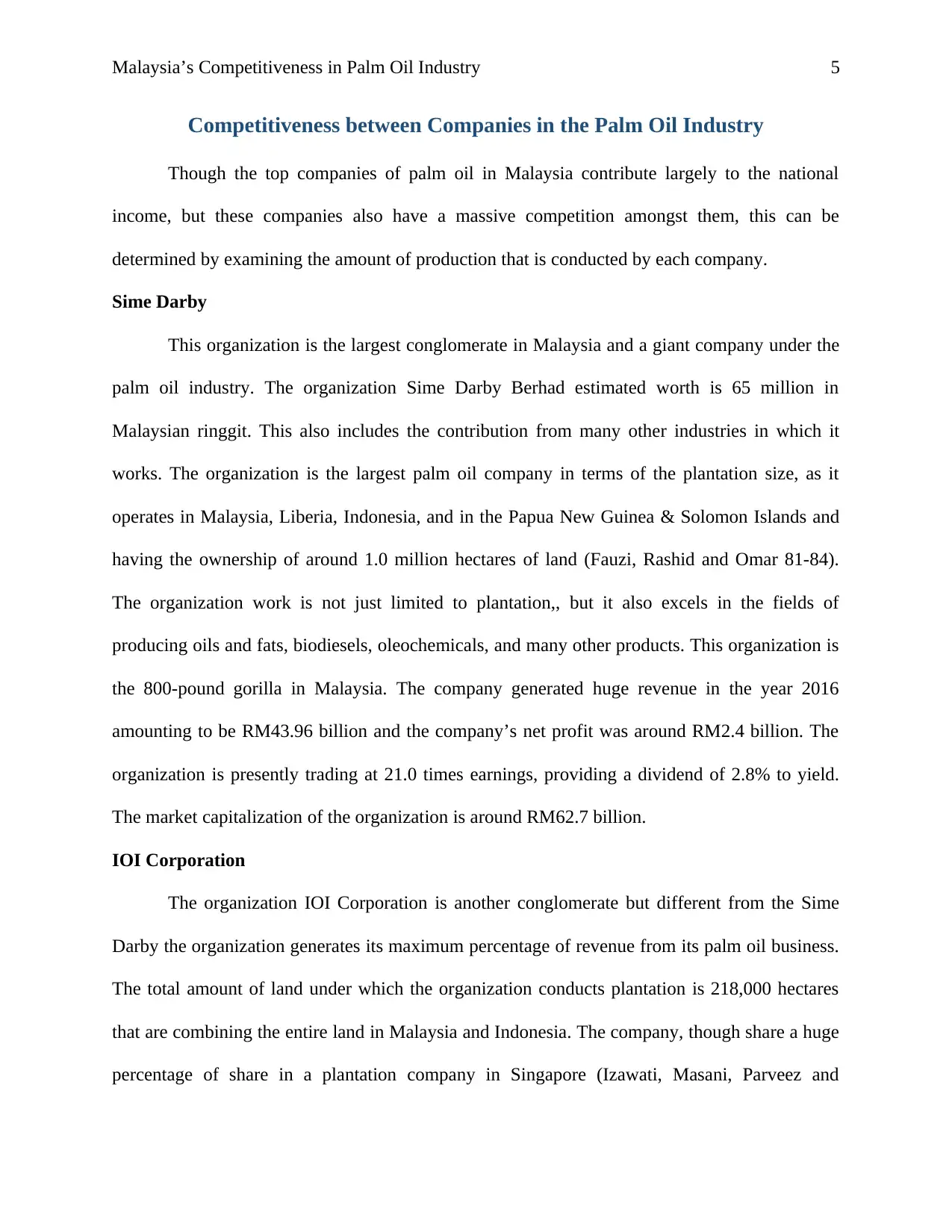
Malaysia’s Competitiveness in Palm Oil Industry 5
Competitiveness between Companies in the Palm Oil Industry
Though the top companies of palm oil in Malaysia contribute largely to the national
income, but these companies also have a massive competition amongst them, this can be
determined by examining the amount of production that is conducted by each company.
Sime Darby
This organization is the largest conglomerate in Malaysia and a giant company under the
palm oil industry. The organization Sime Darby Berhad estimated worth is 65 million in
Malaysian ringgit. This also includes the contribution from many other industries in which it
works. The organization is the largest palm oil company in terms of the plantation size, as it
operates in Malaysia, Liberia, Indonesia, and in the Papua New Guinea & Solomon Islands and
having the ownership of around 1.0 million hectares of land (Fauzi, Rashid and Omar 81-84).
The organization work is not just limited to plantation,, but it also excels in the fields of
producing oils and fats, biodiesels, oleochemicals, and many other products. This organization is
the 800-pound gorilla in Malaysia. The company generated huge revenue in the year 2016
amounting to be RM43.96 billion and the company’s net profit was around RM2.4 billion. The
organization is presently trading at 21.0 times earnings, providing a dividend of 2.8% to yield.
The market capitalization of the organization is around RM62.7 billion.
IOI Corporation
The organization IOI Corporation is another conglomerate but different from the Sime
Darby the organization generates its maximum percentage of revenue from its palm oil business.
The total amount of land under which the organization conducts plantation is 218,000 hectares
that are combining the entire land in Malaysia and Indonesia. The company, though share a huge
percentage of share in a plantation company in Singapore (Izawati, Masani, Parveez and
Competitiveness between Companies in the Palm Oil Industry
Though the top companies of palm oil in Malaysia contribute largely to the national
income, but these companies also have a massive competition amongst them, this can be
determined by examining the amount of production that is conducted by each company.
Sime Darby
This organization is the largest conglomerate in Malaysia and a giant company under the
palm oil industry. The organization Sime Darby Berhad estimated worth is 65 million in
Malaysian ringgit. This also includes the contribution from many other industries in which it
works. The organization is the largest palm oil company in terms of the plantation size, as it
operates in Malaysia, Liberia, Indonesia, and in the Papua New Guinea & Solomon Islands and
having the ownership of around 1.0 million hectares of land (Fauzi, Rashid and Omar 81-84).
The organization work is not just limited to plantation,, but it also excels in the fields of
producing oils and fats, biodiesels, oleochemicals, and many other products. This organization is
the 800-pound gorilla in Malaysia. The company generated huge revenue in the year 2016
amounting to be RM43.96 billion and the company’s net profit was around RM2.4 billion. The
organization is presently trading at 21.0 times earnings, providing a dividend of 2.8% to yield.
The market capitalization of the organization is around RM62.7 billion.
IOI Corporation
The organization IOI Corporation is another conglomerate but different from the Sime
Darby the organization generates its maximum percentage of revenue from its palm oil business.
The total amount of land under which the organization conducts plantation is 218,000 hectares
that are combining the entire land in Malaysia and Indonesia. The company, though share a huge
percentage of share in a plantation company in Singapore (Izawati, Masani, Parveez and
⊘ This is a preview!⊘
Do you want full access?
Subscribe today to unlock all pages.

Trusted by 1+ million students worldwide
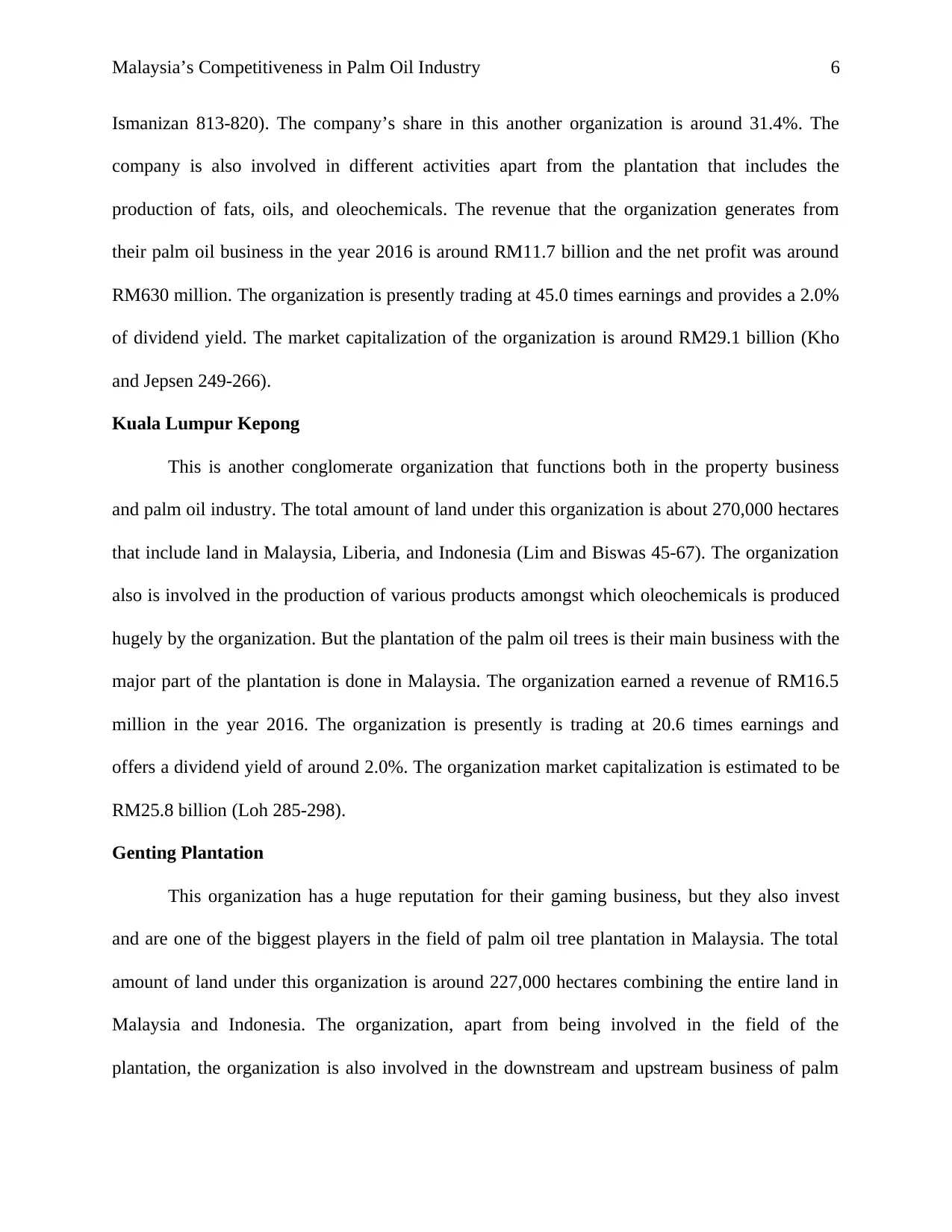
Malaysia’s Competitiveness in Palm Oil Industry 6
Ismanizan 813-820). The company’s share in this another organization is around 31.4%. The
company is also involved in different activities apart from the plantation that includes the
production of fats, oils, and oleochemicals. The revenue that the organization generates from
their palm oil business in the year 2016 is around RM11.7 billion and the net profit was around
RM630 million. The organization is presently trading at 45.0 times earnings and provides a 2.0%
of dividend yield. The market capitalization of the organization is around RM29.1 billion (Kho
and Jepsen 249-266).
Kuala Lumpur Kepong
This is another conglomerate organization that functions both in the property business
and palm oil industry. The total amount of land under this organization is about 270,000 hectares
that include land in Malaysia, Liberia, and Indonesia (Lim and Biswas 45-67). The organization
also is involved in the production of various products amongst which oleochemicals is produced
hugely by the organization. But the plantation of the palm oil trees is their main business with the
major part of the plantation is done in Malaysia. The organization earned a revenue of RM16.5
million in the year 2016. The organization is presently is trading at 20.6 times earnings and
offers a dividend yield of around 2.0%. The organization market capitalization is estimated to be
RM25.8 billion (Loh 285-298).
Genting Plantation
This organization has a huge reputation for their gaming business, but they also invest
and are one of the biggest players in the field of palm oil tree plantation in Malaysia. The total
amount of land under this organization is around 227,000 hectares combining the entire land in
Malaysia and Indonesia. The organization, apart from being involved in the field of the
plantation, the organization is also involved in the downstream and upstream business of palm
Ismanizan 813-820). The company’s share in this another organization is around 31.4%. The
company is also involved in different activities apart from the plantation that includes the
production of fats, oils, and oleochemicals. The revenue that the organization generates from
their palm oil business in the year 2016 is around RM11.7 billion and the net profit was around
RM630 million. The organization is presently trading at 45.0 times earnings and provides a 2.0%
of dividend yield. The market capitalization of the organization is around RM29.1 billion (Kho
and Jepsen 249-266).
Kuala Lumpur Kepong
This is another conglomerate organization that functions both in the property business
and palm oil industry. The total amount of land under this organization is about 270,000 hectares
that include land in Malaysia, Liberia, and Indonesia (Lim and Biswas 45-67). The organization
also is involved in the production of various products amongst which oleochemicals is produced
hugely by the organization. But the plantation of the palm oil trees is their main business with the
major part of the plantation is done in Malaysia. The organization earned a revenue of RM16.5
million in the year 2016. The organization is presently is trading at 20.6 times earnings and
offers a dividend yield of around 2.0%. The organization market capitalization is estimated to be
RM25.8 billion (Loh 285-298).
Genting Plantation
This organization has a huge reputation for their gaming business, but they also invest
and are one of the biggest players in the field of palm oil tree plantation in Malaysia. The total
amount of land under this organization is around 227,000 hectares combining the entire land in
Malaysia and Indonesia. The organization, apart from being involved in the field of the
plantation, the organization is also involved in the downstream and upstream business of palm
Paraphrase This Document
Need a fresh take? Get an instant paraphrase of this document with our AI Paraphraser
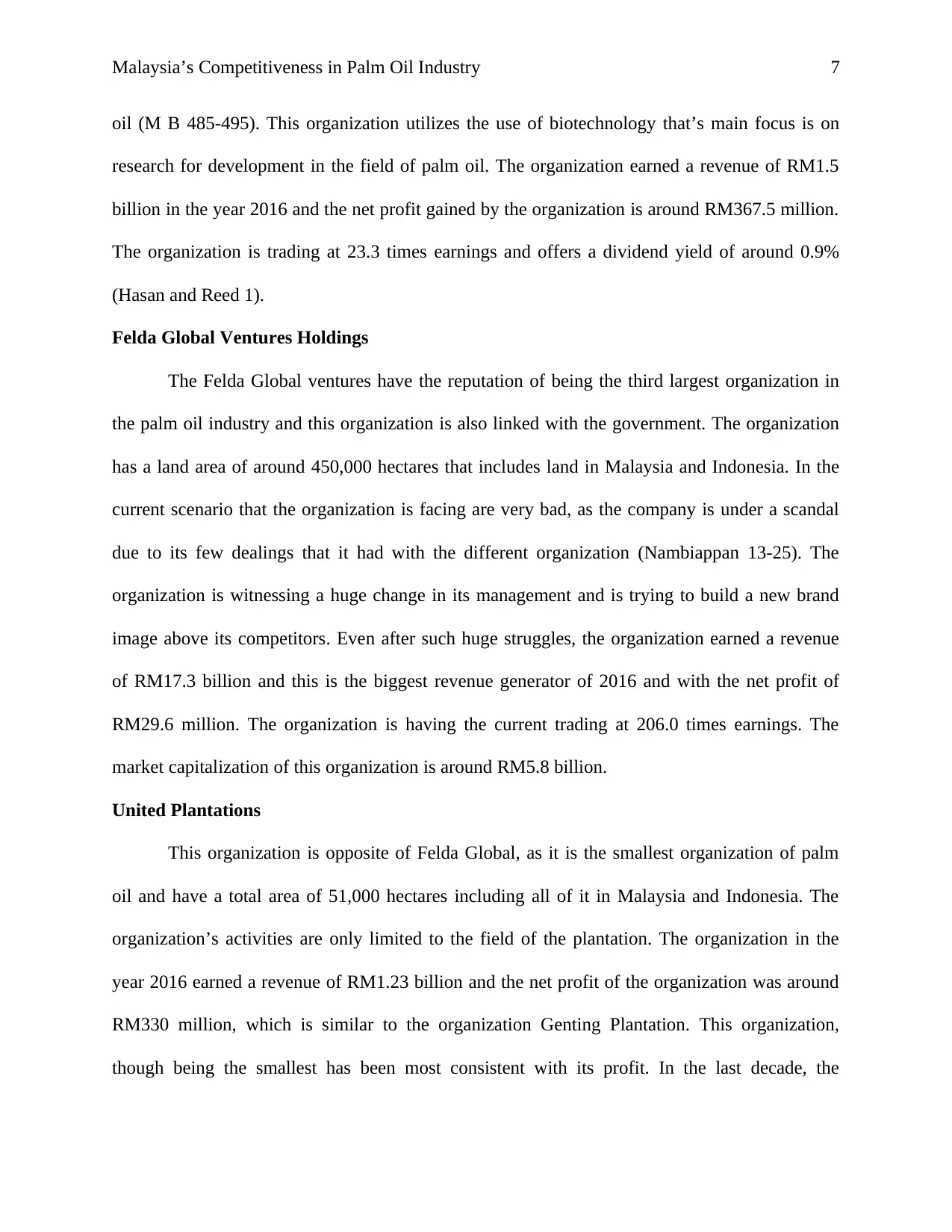
Malaysia’s Competitiveness in Palm Oil Industry 7
oil (M B 485-495). This organization utilizes the use of biotechnology that’s main focus is on
research for development in the field of palm oil. The organization earned a revenue of RM1.5
billion in the year 2016 and the net profit gained by the organization is around RM367.5 million.
The organization is trading at 23.3 times earnings and offers a dividend yield of around 0.9%
(Hasan and Reed 1).
Felda Global Ventures Holdings
The Felda Global ventures have the reputation of being the third largest organization in
the palm oil industry and this organization is also linked with the government. The organization
has a land area of around 450,000 hectares that includes land in Malaysia and Indonesia. In the
current scenario that the organization is facing are very bad, as the company is under a scandal
due to its few dealings that it had with the different organization (Nambiappan 13-25). The
organization is witnessing a huge change in its management and is trying to build a new brand
image above its competitors. Even after such huge struggles, the organization earned a revenue
of RM17.3 billion and this is the biggest revenue generator of 2016 and with the net profit of
RM29.6 million. The organization is having the current trading at 206.0 times earnings. The
market capitalization of this organization is around RM5.8 billion.
United Plantations
This organization is opposite of Felda Global, as it is the smallest organization of palm
oil and have a total area of 51,000 hectares including all of it in Malaysia and Indonesia. The
organization’s activities are only limited to the field of the plantation. The organization in the
year 2016 earned a revenue of RM1.23 billion and the net profit of the organization was around
RM330 million, which is similar to the organization Genting Plantation. This organization,
though being the smallest has been most consistent with its profit. In the last decade, the
oil (M B 485-495). This organization utilizes the use of biotechnology that’s main focus is on
research for development in the field of palm oil. The organization earned a revenue of RM1.5
billion in the year 2016 and the net profit gained by the organization is around RM367.5 million.
The organization is trading at 23.3 times earnings and offers a dividend yield of around 0.9%
(Hasan and Reed 1).
Felda Global Ventures Holdings
The Felda Global ventures have the reputation of being the third largest organization in
the palm oil industry and this organization is also linked with the government. The organization
has a land area of around 450,000 hectares that includes land in Malaysia and Indonesia. In the
current scenario that the organization is facing are very bad, as the company is under a scandal
due to its few dealings that it had with the different organization (Nambiappan 13-25). The
organization is witnessing a huge change in its management and is trying to build a new brand
image above its competitors. Even after such huge struggles, the organization earned a revenue
of RM17.3 billion and this is the biggest revenue generator of 2016 and with the net profit of
RM29.6 million. The organization is having the current trading at 206.0 times earnings. The
market capitalization of this organization is around RM5.8 billion.
United Plantations
This organization is opposite of Felda Global, as it is the smallest organization of palm
oil and have a total area of 51,000 hectares including all of it in Malaysia and Indonesia. The
organization’s activities are only limited to the field of the plantation. The organization in the
year 2016 earned a revenue of RM1.23 billion and the net profit of the organization was around
RM330 million, which is similar to the organization Genting Plantation. This organization,
though being the smallest has been most consistent with its profit. In the last decade, the
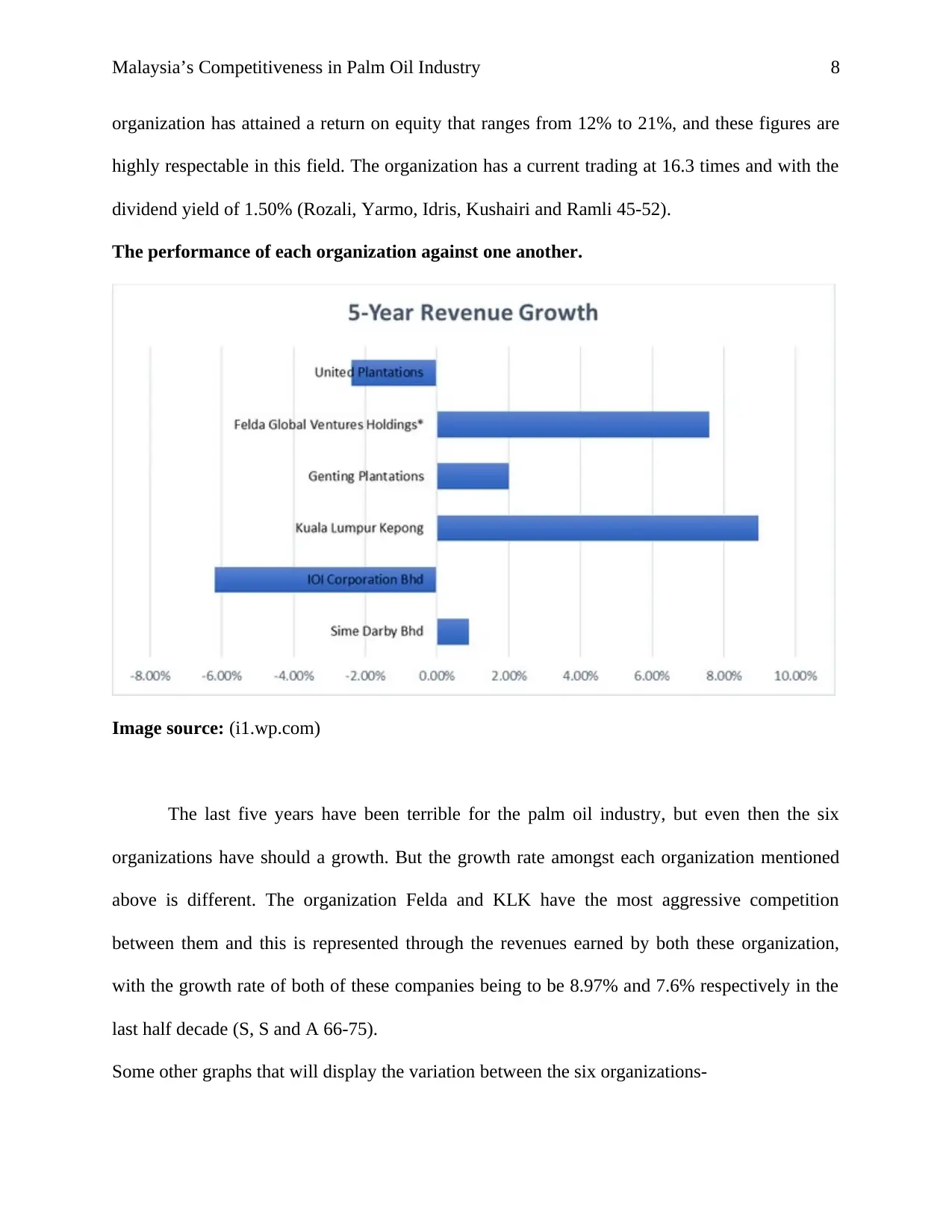
Malaysia’s Competitiveness in Palm Oil Industry 8
organization has attained a return on equity that ranges from 12% to 21%, and these figures are
highly respectable in this field. The organization has a current trading at 16.3 times and with the
dividend yield of 1.50% (Rozali, Yarmo, Idris, Kushairi and Ramli 45-52).
The performance of each organization against one another.
Image source: (i1.wp.com)
The last five years have been terrible for the palm oil industry, but even then the six
organizations have should a growth. But the growth rate amongst each organization mentioned
above is different. The organization Felda and KLK have the most aggressive competition
between them and this is represented through the revenues earned by both these organization,
with the growth rate of both of these companies being to be 8.97% and 7.6% respectively in the
last half decade (S, S and A 66-75).
Some other graphs that will display the variation between the six organizations-
organization has attained a return on equity that ranges from 12% to 21%, and these figures are
highly respectable in this field. The organization has a current trading at 16.3 times and with the
dividend yield of 1.50% (Rozali, Yarmo, Idris, Kushairi and Ramli 45-52).
The performance of each organization against one another.
Image source: (i1.wp.com)
The last five years have been terrible for the palm oil industry, but even then the six
organizations have should a growth. But the growth rate amongst each organization mentioned
above is different. The organization Felda and KLK have the most aggressive competition
between them and this is represented through the revenues earned by both these organization,
with the growth rate of both of these companies being to be 8.97% and 7.6% respectively in the
last half decade (S, S and A 66-75).
Some other graphs that will display the variation between the six organizations-
⊘ This is a preview!⊘
Do you want full access?
Subscribe today to unlock all pages.

Trusted by 1+ million students worldwide
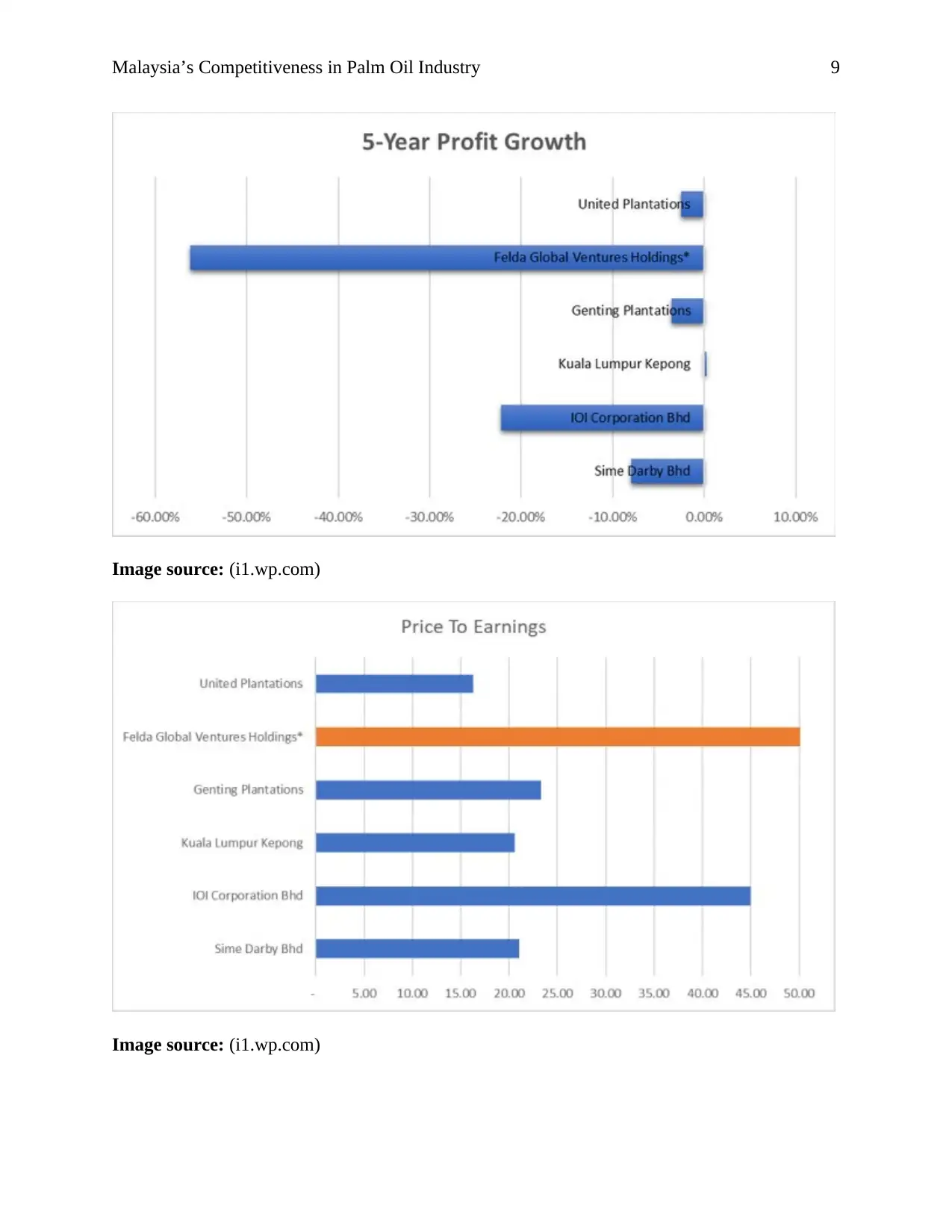
Malaysia’s Competitiveness in Palm Oil Industry 9
Image source: (i1.wp.com)
Image source: (i1.wp.com)
Image source: (i1.wp.com)
Image source: (i1.wp.com)
Paraphrase This Document
Need a fresh take? Get an instant paraphrase of this document with our AI Paraphraser
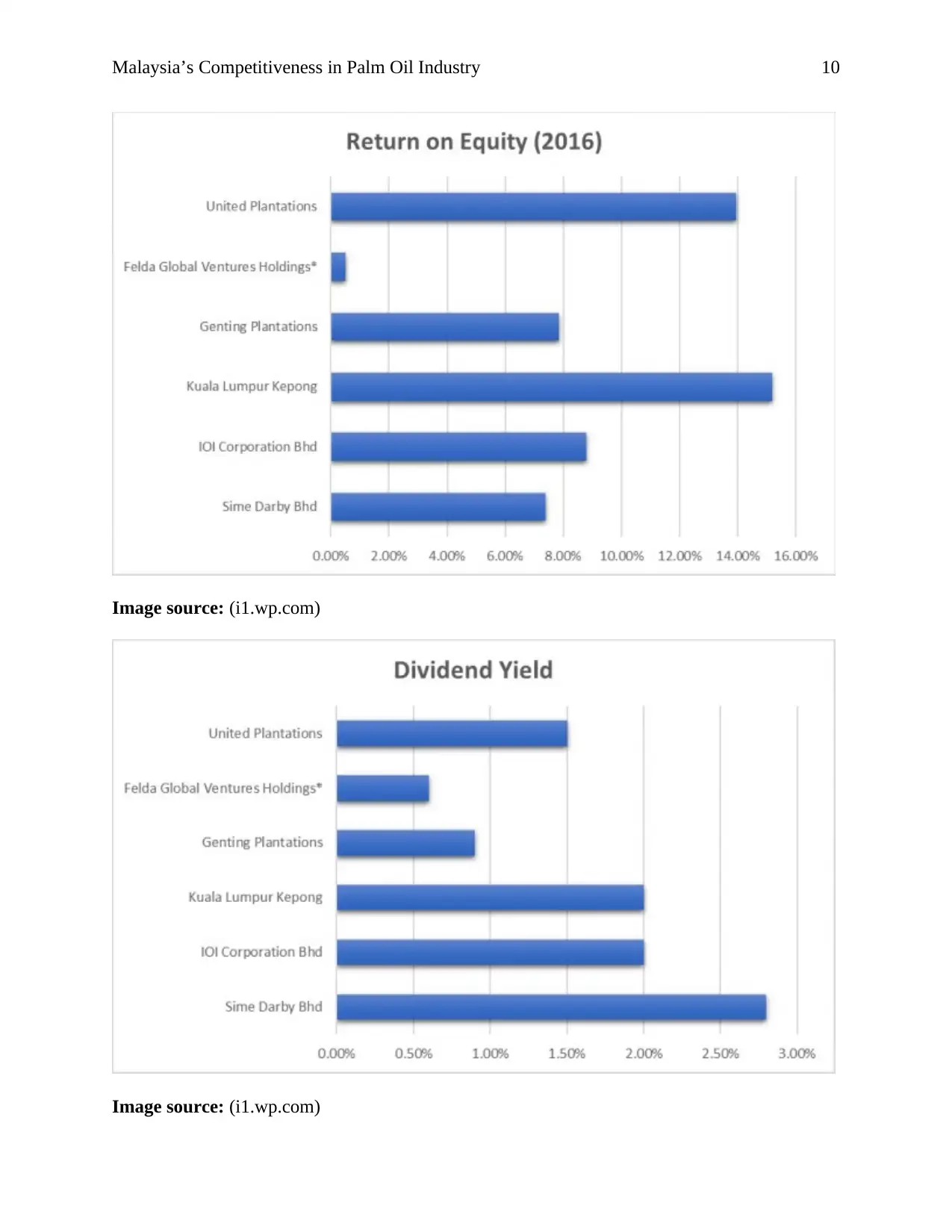
Malaysia’s Competitiveness in Palm Oil Industry 10
Image source: (i1.wp.com)
Image source: (i1.wp.com)
Image source: (i1.wp.com)
Image source: (i1.wp.com)
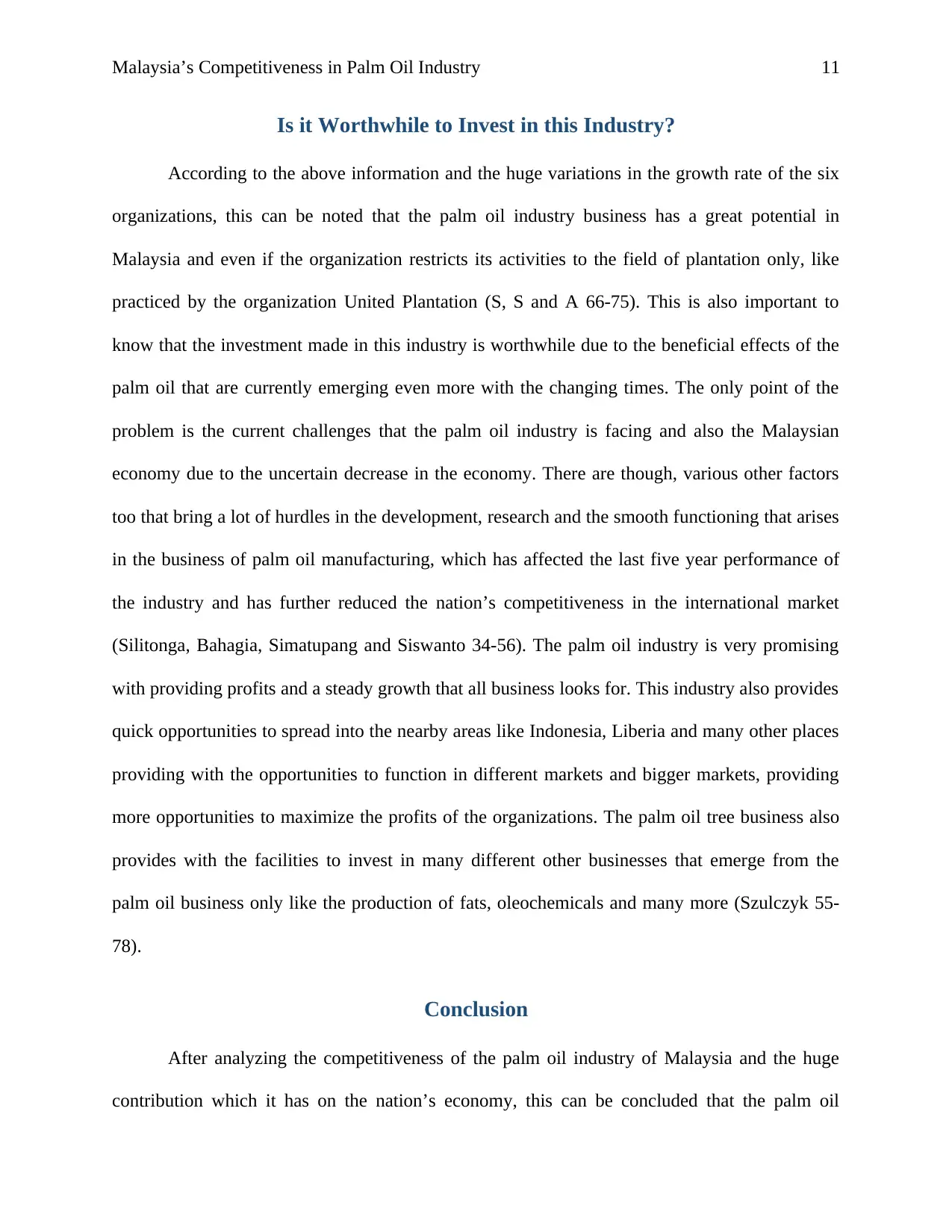
Malaysia’s Competitiveness in Palm Oil Industry 11
Is it Worthwhile to Invest in this Industry?
According to the above information and the huge variations in the growth rate of the six
organizations, this can be noted that the palm oil industry business has a great potential in
Malaysia and even if the organization restricts its activities to the field of plantation only, like
practiced by the organization United Plantation (S, S and A 66-75). This is also important to
know that the investment made in this industry is worthwhile due to the beneficial effects of the
palm oil that are currently emerging even more with the changing times. The only point of the
problem is the current challenges that the palm oil industry is facing and also the Malaysian
economy due to the uncertain decrease in the economy. There are though, various other factors
too that bring a lot of hurdles in the development, research and the smooth functioning that arises
in the business of palm oil manufacturing, which has affected the last five year performance of
the industry and has further reduced the nation’s competitiveness in the international market
(Silitonga, Bahagia, Simatupang and Siswanto 34-56). The palm oil industry is very promising
with providing profits and a steady growth that all business looks for. This industry also provides
quick opportunities to spread into the nearby areas like Indonesia, Liberia and many other places
providing with the opportunities to function in different markets and bigger markets, providing
more opportunities to maximize the profits of the organizations. The palm oil tree business also
provides with the facilities to invest in many different other businesses that emerge from the
palm oil business only like the production of fats, oleochemicals and many more (Szulczyk 55-
78).
Conclusion
After analyzing the competitiveness of the palm oil industry of Malaysia and the huge
contribution which it has on the nation’s economy, this can be concluded that the palm oil
Is it Worthwhile to Invest in this Industry?
According to the above information and the huge variations in the growth rate of the six
organizations, this can be noted that the palm oil industry business has a great potential in
Malaysia and even if the organization restricts its activities to the field of plantation only, like
practiced by the organization United Plantation (S, S and A 66-75). This is also important to
know that the investment made in this industry is worthwhile due to the beneficial effects of the
palm oil that are currently emerging even more with the changing times. The only point of the
problem is the current challenges that the palm oil industry is facing and also the Malaysian
economy due to the uncertain decrease in the economy. There are though, various other factors
too that bring a lot of hurdles in the development, research and the smooth functioning that arises
in the business of palm oil manufacturing, which has affected the last five year performance of
the industry and has further reduced the nation’s competitiveness in the international market
(Silitonga, Bahagia, Simatupang and Siswanto 34-56). The palm oil industry is very promising
with providing profits and a steady growth that all business looks for. This industry also provides
quick opportunities to spread into the nearby areas like Indonesia, Liberia and many other places
providing with the opportunities to function in different markets and bigger markets, providing
more opportunities to maximize the profits of the organizations. The palm oil tree business also
provides with the facilities to invest in many different other businesses that emerge from the
palm oil business only like the production of fats, oleochemicals and many more (Szulczyk 55-
78).
Conclusion
After analyzing the competitiveness of the palm oil industry of Malaysia and the huge
contribution which it has on the nation’s economy, this can be concluded that the palm oil
⊘ This is a preview!⊘
Do you want full access?
Subscribe today to unlock all pages.

Trusted by 1+ million students worldwide
1 out of 16
Related Documents
Your All-in-One AI-Powered Toolkit for Academic Success.
+13062052269
info@desklib.com
Available 24*7 on WhatsApp / Email
![[object Object]](/_next/static/media/star-bottom.7253800d.svg)
Unlock your academic potential
Copyright © 2020–2025 A2Z Services. All Rights Reserved. Developed and managed by ZUCOL.




